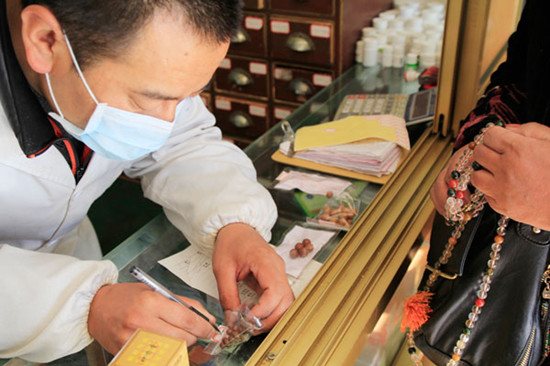
Pharmacist Tenzin writes the name of a traditionally made Tibetan drug on a tag for patients. Wang Huazhong / China Daily
Past and present
Tseten Jigme said monasteries, both big and small, have spent money to train their in-house monk-doctors since ancient times.
The rise of monk-doctors began in the late eighth century, when Yuthok Yonten Gonpo founded the Tibetan medical science.
Since 1696, Desi Sangye Gyatso, regent of Tibet in the 17th century after the passing of the fifth Dalai Lama, established a medical college on the Chakpori Hill, and later another one beside the Potala Palace and a third one in Doilungdeqen county.
The colleges only admitted monks then.
In 1916, the predecessor of the Hospital of Tibetan Medical Science was established, with a tradition of selecting most students and practitioners from monasteries unchanged.
From 1916 to 1959, the colleges and hospitals trained more than 1,000 monk-doctors but only one female doctor, according to Tseten Jigme.
Then in 1959, the Chakpori Hill Medical College merged with another college to form today's Hospital of Tibetan Medical Science and began accepting students from society.
"Nowadays, we have few monk-doctors because there are professional hospitals and clinics everywhere in every county and village," said Tseten Jigme.
In 2011, the autonomous region's government began allowing monks and nuns to join the social medical insurance system on a voluntary basis. In 2012, hospitals began providing free body examinations to them.
"So, the need for monk-doctors has decreased substantially along with the development of the modern health system," Tseten Jigme said.
He added that the monk-doctors now can be found in the Sera, Drepung, Ganden, Tashilhunpo and Samding monasteries. Yet only the ones in Drepung and Tashilhunpo are open to the public.
Norbu, head of the medical administrative office of Lhasa city's health department, said authorities do not have an exact number of the group.

Copyright ©1999-2011 Chinanews.com. All rights reserved.
Reproduction in whole or in part without permission is prohibited.